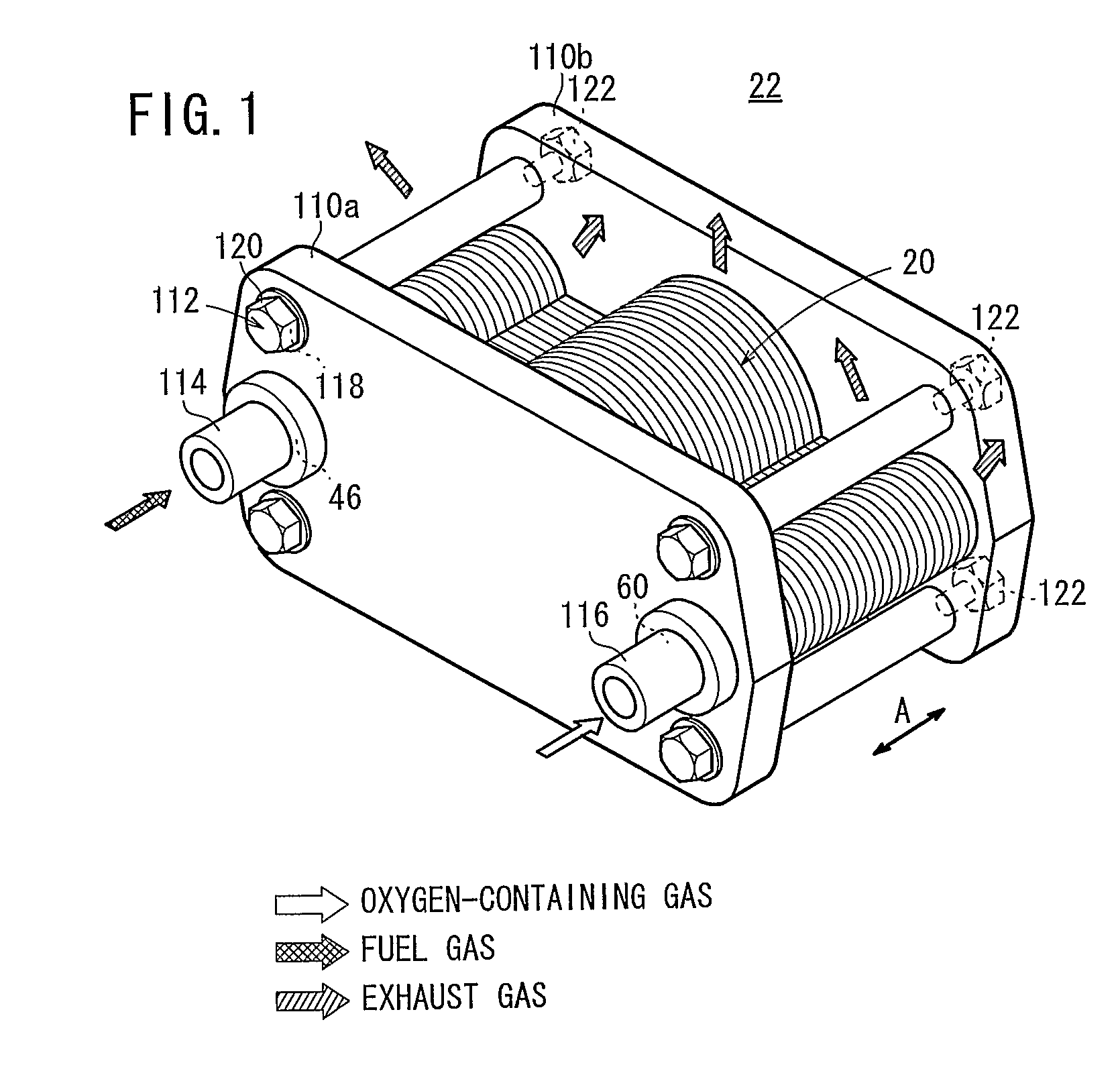Fuel cell comprising separator with protrusions in zigzag-pattern
a separator and zigzag-pattern technology, applied in the field of fuel cells, can solve the problems of separator deformation, power generation efficiency lowering undesired, small contact area between separator and mea, etc., and achieve the effect of improving power generation efficiency
- Summary
- Abstract
- Description
- Claims
- Application Information
AI Technical Summary
Benefits of technology
Problems solved by technology
Method used
Image
Examples
first embodiment
[0049]FIG. 1 is a perspective view schematically showing a fuel cell stack 22 formed by stacking a plurality of fuel cells 20 according to the present invention in a direction indicated by an arrow A.
[0050]The fuel cell 20 is a solid oxide fuel cell (SOFC) used in various applications, including stationary and mobile applications. For example, the fuel cell 20 is mounted on a vehicle. As shown in FIGS. 2 and 3, the fuel cell 20 includes an electrolyte electrode assembly 36. The electrolyte electrode assembly 36 includes a cathode 32, an anode 34, and an electrolyte (electrolyte plate) 30 interposed between the cathode 32 and the anode 34. For example, the electrolyte 30 is made of ion-conductive solid oxide such as stabilized zirconia. The electrolyte electrode assembly 36 has a circular disk shape.
[0051]The fuel cell 20 is formed by sandwiching a single electrolyte electrode assembly 36 between a pair of separators 38 according to the first embodiment. The separator 38 includes fir...
fourth embodiment
[0124]FIG. 18 is an exploded perspective view showing a fuel cell 270 according to the present invention.
[0125]The fuel cell 270 includes a plurality of, e.g., four electrolyte electrode assemblies 36 and a pair of separators 272 sandwiching the electrolyte electrode assemblies 36. Each of the separators 272 includes a first plate 274 and a second plate 276. For example, the first and second plates 274, 276 are metal plates of, e.g., stainless alloy.
[0126]A first fuel gas supply section 278 is formed at the center of the first plate 274, and the fuel gas supply passage 46 extends through the first fuel gas supply section 278. Four first bridges 280 extend radially outwardly from the first fuel gas supply section 278 at equal intervals. The first fuel gas supply section 278 is integral with first sandwiching sections 282 each having a relatively large diameter through the first bridges 280. The first sandwiching section 282 and the electrolyte electrode assembly 36 have substantially...
fifth embodiment
[0140]FIG. 21 is an exploded perspective view showing a fuel cell 310 according to the present invention.
[0141]The fuel cell 310 is formed by sandwiching a plurality of, e.g., four electrolyte electrode assemblies 36 between a pair of separators 312. A first fuel gas supply section 314 is formed at the center of the separator 312, and the fuel gas supply passage 46 extends through the first fuel gas supply section 314. Four first bridges 316 extend radially outwardly from the first fuel gas supply section 314 at equal intervals. The first bridges 316 are integral with first sandwiching sections 318 each having a circular disk shape.
[0142]The centers of the sandwiching sections 318 are equally distanced from the center of the first fuel gas supply section 314. The sandwiching sections 318 are separated from each other. A plurality of first projections 56 forming the fuel gas channel 54 are provided on a surface 318a of the sandwiching section 318 which contacts the anode 34.
[0143]A f...
PUM
 Login to View More
Login to View More Abstract
Description
Claims
Application Information
 Login to View More
Login to View More - R&D
- Intellectual Property
- Life Sciences
- Materials
- Tech Scout
- Unparalleled Data Quality
- Higher Quality Content
- 60% Fewer Hallucinations
Browse by: Latest US Patents, China's latest patents, Technical Efficacy Thesaurus, Application Domain, Technology Topic, Popular Technical Reports.
© 2025 PatSnap. All rights reserved.Legal|Privacy policy|Modern Slavery Act Transparency Statement|Sitemap|About US| Contact US: help@patsnap.com



